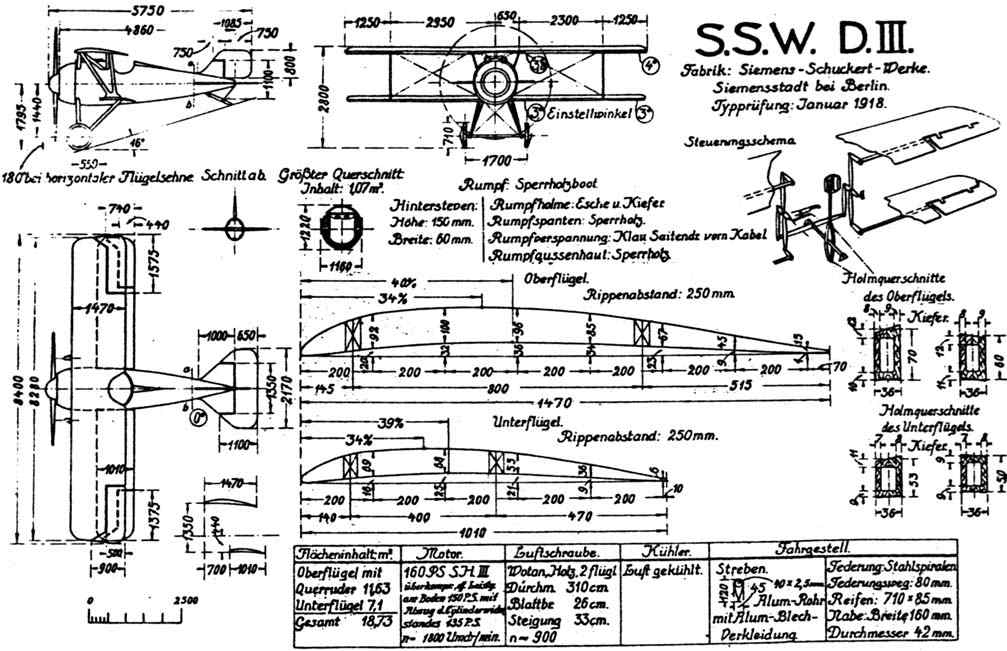Siemens-Schuckert D.III on:
[Wikipedia]
[Google]
[Amazon]
__NOTOC__
The Siemens-Schuckert D.III was a German single-seat fighter built by

Siemens-Schuckert
Siemens-Schuckert (or Siemens-Schuckertwerke) was a German electrical engineering company headquartered in Berlin, Erlangen and Nuremberg that was incorporated into the Siemens AG in 1966.
Siemens Schuckert was founded in 1903 when Siemens & H ...
Werke. The D.III was a development of the earlier Siemens-Schuckert D.IIc prototype.Green and Swanborough 1994, p. 530. The D.III was an (nearly) equal-span biplane
A biplane is a fixed-wing aircraft with two main wings stacked one above the other. The first powered, controlled aeroplane to fly, the Wright Flyer, used a biplane wing arrangement, as did many aircraft in the early years of aviation. While a ...
powered by a 160 hp (119 kW) Siemens-Halske Sh.III
Siemens-Halske's Sh.III was an 11-cylinder, air-cooled counter rotary engine developed in Germany during World War I. The engine was a development of the earlier 9-cylinder Siemens-Halske Sh.I.
Design
The Siemens-Halske Sh.III was an 11-cylind ...
bi-rotary engine. ''Idflieg'' placed an order for 20 aircraft in December 1917, followed by a second order of 30 aircraft in February 1918.Gray and Thetford 1962, p. 213.
Operational history
Approximately 41 D.IIIs were delivered to frontline units between April and May 1918. Most aircraft were supplied to ''Jagdgeschwader'' II,VanWyngarden 2005, p. 43. whose pilots were enthusiastic about the new aircraft's handling and rate of climb. After only seven to 10 hours of service, however, the Sh.III engines started showing serious problems with overheating and piston seizure.Gray and Thetford 1962, p. 214. The problem was later traced to the ''Voltol'' mineral oil that was used to replace the now-scarcecastor oil
Castor oil is a vegetable oil pressed from castor beans.
It is a colourless or pale yellow liquid with a distinct taste and odor. Its boiling point is and its density is 0.961 g/cm3. It includes a mixture of triglycerides in which abou ...
. Furthermore, the close-fitting engine cowling provided inadequate cooling to the engine.Gray and Thetford 1962, p. 215.
In late May 1918, ''Jagdgeschwader'' II replaced its D.IIIs with the older Fokker Dr.I
The Fokker Dr.I (''Dreidecker'', "triplane" in German), often known simply as the Fokker Triplane, was a World War I fighter aircraft built by Fokker-Flugzeugwerke. The Dr.I saw widespread service in the spring of 1918. It became famous as th ...
.VanWyngarden 2005, p. 44. The remaining D.III aircraft were returned to the Siemens-Schuckert factory, where they were retrofitted with new Sh.IIIa engines, an enlarged rudder, and cutaway cowlings that provided improved airflow. A further 30 new production D.IIIs incorporated these modifications. Total production amounted to 80 aircraft.
In July 1918, the D.III returned to active service as an interceptor with home defense squadrons. By this time, the D.III had been replaced in production by the Siemens-Schuckert D.IV
The Siemens-Schuckert D.IV was a late- World War I fighter aircraft from Siemens-Schuckert (SSW). It reached service too late and was produced in too few numbers to have any effect on the war effort.
Earlier designs
Siemens-Schuckert's first prod ...
.
Operators
; *''Luftstreitkräfte
The ''Deutsche Luftstreitkräfte'' (, German Air Force)—known before October 1916 as (Flyer Troops)—was the air arm of the Imperial German Army. In English-language sources it is usually referred to as the Imperial German Air Service, alth ...
''
;
*Swiss Air Force
The Swiss Air Force (german: Schweizer Luftwaffe; french: Forces aériennes suisses; it, Forze aeree svizzere; rm, Aviatica militara svizra) is the air component of the Swiss Armed Forces, established on 31 July 1914 as a part of the army and ...
Specifications

References
Notes
Bibliography
* Gray, Peter and Owen Thetford. ''German Aircraft of the First World War''. London: Putnam, 1962. . * Green, William and Gordon Swanborough. ''The Complete Book of Fighters.'' London: Salamander Books, 1994. . * VanWyngarden, Greg. ''Jagdgeschwader Nr II Geschwader 'Berthold' (Aviation Elite Units No. 19).'' Oxford: Osprey Publishing, 2005. . {{Authority control 1910s German fighter aircraft D.III Sesquiplanes Single-engined tractor aircraft Aircraft first flown in 1917 Rotary-engined aircraft